Symposium for UAL design students: youth mental health with NSFT
Following the Early Lab talks across UAL about the project, interested students attend a one-day symposium in Hackney presenting youth mental health in the context of design for social innovation. A day of workshops and talks about the subject, design methods, tools and processes preparing potential Early Lab student team members. Students get to meet NSFT service users and clinicians as well as designers and researchers active in the field.
24 Feb 2015. An account of the symposium workshop and talks that gave interested UAL students a greater insight into the forthcoming project with NSFT.
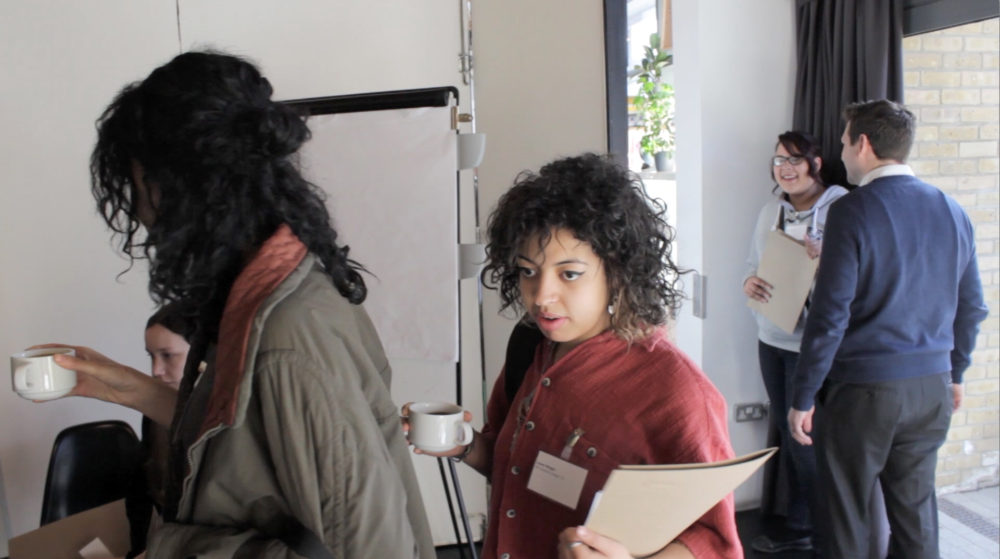
Symposium
The aim of the symposium was two fold:
- to introduce those students (about forty attendees), interested in participating in the project with NSFT, to the issue of youth mental health
- and to guide them through a variety of engagement methodologies and design processes that can be used in relation to the issue of youth mental health.
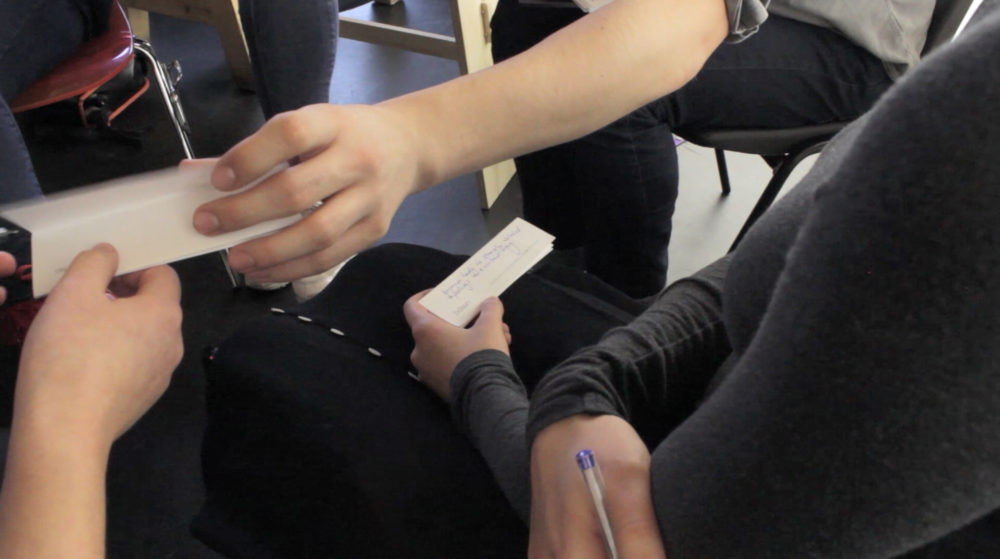
Workshop 1/2 by Bidean
The day began with the first of two workshops by Bidean, a social enterprise co-founded by two Central Saint Martins alum (Erika Renedo Illarregi and Pras Gunasekera) that uses co-design methodologies in the field of mental health with the aim of transforming ‘needs into assets’.
Workshop 1 was an ice-breaker exercise, a great leveller that introduced the students to the ‘variety and individuality of the notions of madness’. All attendees were asked to write down, anonymously, onto a piece of paper the most crazy, extraordinary ‘mental’ thing they have ever done and then drop them into a pot. Everyone was then invited to reach into the pot and pick a random a piece of paper, unfold it and read it aloud. Each person kept that piece of paper, written on by someone else, and would return to it again at the end of the day. Many of the students reported that they were deeply moved by this experience (see student testimony of the symposium here [insert link to Impact]).
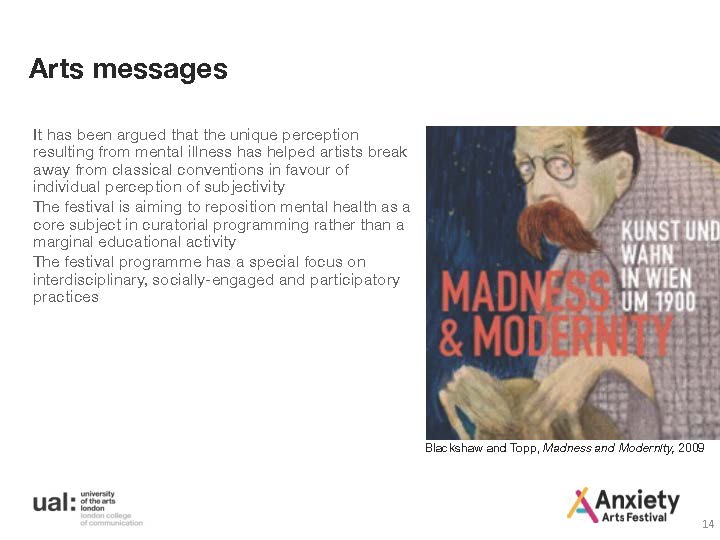
Talk 1/3 – Errol Francis: Anxiety Arts Festival, Institute of Inner Vision
Errol Francis then gave a fascinating presentation of the connections between the Anxiety Arts Festival (of which he is Director) and the Institute of Inner Vision at London College of Communication. He showed selected highlights of visual art, film (particularly the use of flashback – ‘reaching back for buried memories’) and performance events from the festival that took place in 2014. In this event, public health and artistic motivations combine to illustrate how mental health is in itself a form of communication.

Talk 2/3 – Angela Hodgson-Teall: drawing on the nature of empathy
The session before lunch took an intriguingly oblique turn with Angela Hodgson-Teall (artist, microbiologist and PhD student at Chelsea) presenting her collaborative art practice performed with patients and staff in the corridors of an NHS hospital in South-East London. Angela describes her practice as ‘drawing social sculpture from everyday interactions’. In her talk she referenced Daniel Stern’s concept of ‘evoked companions’ (from psychoanalysis) as a consequence of her repeated interactions with the same people through her repeated appearances in the corridors of the hospital. She would later entice symposium attendees to perform one of her ’empathic interventions’ during the afternoon break (see below).
Talk 3/3 – Lorraine Gamman: socially responsive design
After lunch Lorraine Gamman (founder and director, Design Against Crime Research Centre, Central Saint Martins) gave a typically passionate and direct talk in appealing for a methodology she calls ‘socially responsive design’ through the work of Design Against Crime (DACRC). By socially responsive DACRC means ‘design can be responsive to societal challenges but not responsible for them’ – departing from the arrogance of more traditional design approaches. Lorraine talked about how DACRC brings interdisciplinary teams together ‘to help co-develop design questions, contribute knowledge and insights and co-develop and review design proposals/design tools to ensure they are effective and appropriate responses to the issues being addressed. Nearly all the students present had no knowledge or experience of methods of design for social innovation and many cited Lorraine’s talk as the highlight of the day.
One of the key points in her talk was ‘the case for effectuation‘ (from cognitive scientist Dr Saras Sarasvathy) which learns from the logic successful entrepreneurs apply. It is ‘a way of thinking about making decisions when non-predictive control is required’. Lorraine makes the point that ‘whilst we may not be able to ‘control’ the future we can maintain agency’ (see a slide from her presentation below). The concept of effectuation becomes significant when taking an asset-based approach in engaging groups of people who have experience of using or providing social services.
Student feedback indicated that Lorraine’s talk played an important part in their preparation for the project with NSFT (see student testimony of the symposium here [insert link to Impact]).
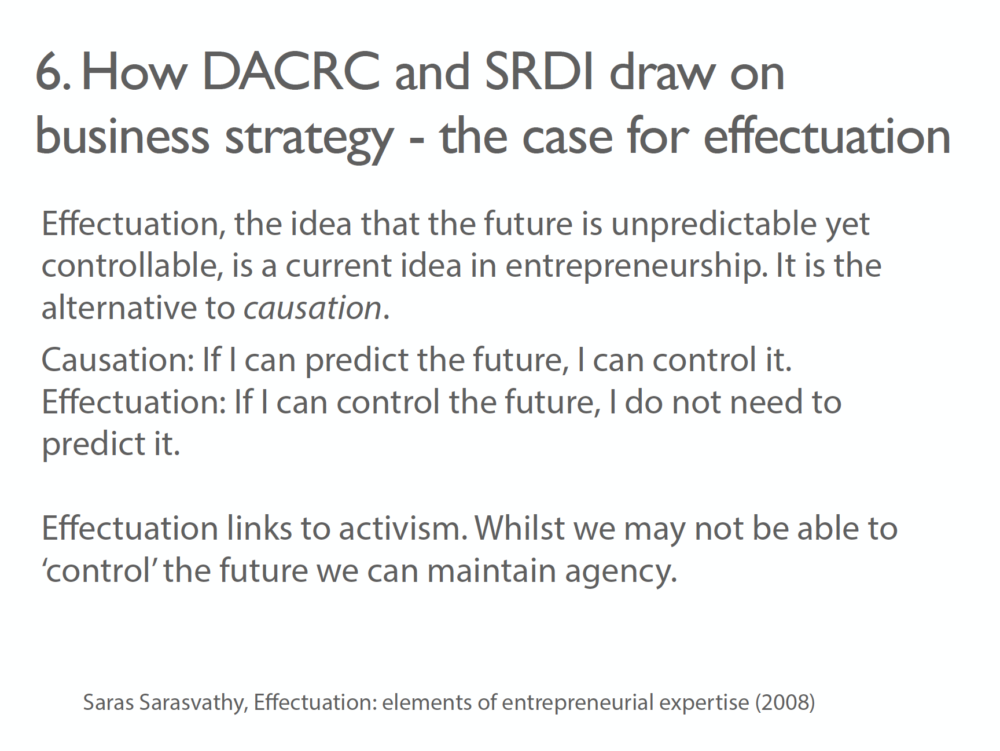
Double-blind drawing performance
During the afternoon break Angela Hodgson-Teall engaged a number of attendees into performing a double-blind drawing session lying flat on sheets of white cartridge paper on the floor with a pencil in each hand. Performers included Early Lab co-founder Fabiane Lee-Perrella, pictured below.

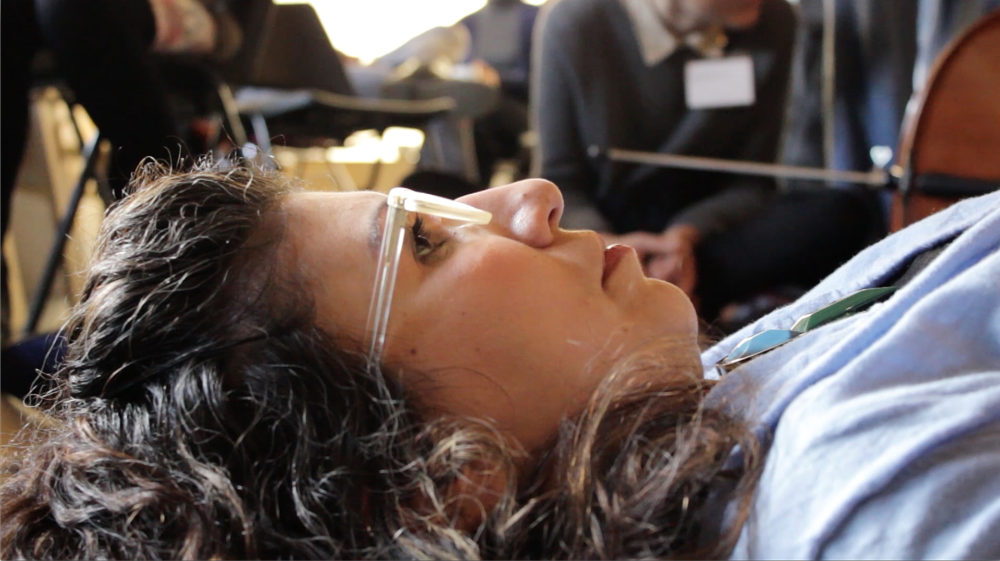
Workshop 2/2 by Bidean
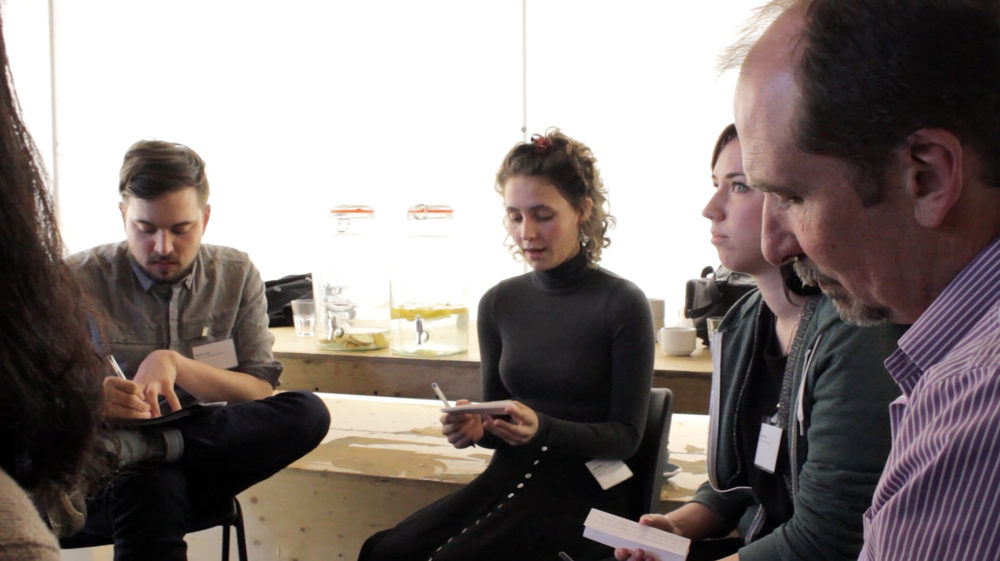
Workshop 2 by Pras and Erika of Bidean explored their methodology of the ‘infinite whys’ using the ‘connectivity tree’. With everyone split into small working groups each attendee got a chance to articulate insights following a day of reflecting on the statement they picked randomly out of the pot in the morning and read-aloud. Every group member responded to ‘why’ (why might the person do that crazy thing they wrote about on the piece of paper?) and drilled down to a set of shared and diverging reasons for the this action.
Once every attendee had a chance to articulate the ‘why’ (taking about 15-20 mins) the metaphor of a tree was used (roots, trunk and branches) to map the ‘whys’, (the perceived causes) and link/relate these to one another. This exercise explores the connectivity of problems/insights and causes, encouraging participants to look at the relationships between individual experiences and insights rather than viewing them in isolation or in an exclusively symptomatic way. This workshop gave everyone the opportunity to exercise their powers of empathy and as the student testimonies (here) [add link to content in Impact] indicate, it was a profound and enlightening experience for them.
Reflection – Dr Jon Wilson: youth mental health
The day ended with an informal discussion about the current state of youth mental health in the UK as it appears to Dr Jon Wilson, Consultant Psychiatrist and Deputy Medical Director (Research) at Norfolk & Suffolk NHS Foundation Trust (NSFT).
Jon confirmed that the day had exposed unfamiliar areas of design practice to him and his team, (his fellow clinicians and the NSFT Youth Council members (service users) who were in attendance). He expressed that as a result of this exposure his team were excited at the prospect of engaging in this kind of design practice with UAL students to unearth much needed new visions for their youth mental health service.
As a member of the coalition government’s Taskforce for youth mental health, Jon was able to confirm that the Taskforce recognises that something is fundamentally wrong with services for young people and that this is a problem shared nationally. He said that service engagement needs to be more interesting and appear as appropriate to young people. He said that service schemes such as IAPT (Improving Access to Psychological Therapies – an NHS England initiative) are good for those that manage to engage with them but that unfortunately the evidence shows that young people are not engaging with it. Generally, he said, services don’t appear relevant to 14 to 25 year olds.
Jon asked what will it take for youth mental health services to be fit for purpose? He pointed to the need for a paradigm shift: for rethought online media spaces and physical locations young people want to use that can facilitate the kind of engagement that feels relevant to them and on their terms – as free of stigma as is currently realistically possible. Jon also made comment on the need for preventative resources in the shape of peer-to-peer support workers in all schools (connected to psychiatrists but not actually psychiatrists).
Jon’s reflection on the state of youth mental health provided a very good first overview on issues for the UAL students who were captivated as he talked, asked questions and eagerly scribbled notes as Jon took the symposium well beyond its planned finish time. It was the perfect ending to the day with everyone buzzing as a result of all they had heard and excited at the prospect of the project to come.
Closing remarks
As attendees moved towards the bar, Nick and Fabiane thanked everyone for coming and clarified the student selection process for the Early Lab field trip team. Students were invited to email their applications by next week to present the abilities and insights they think they would contribute to the project.
Next steps
On receipt of student applications, Nick and Fabiane would process them and select students for the project team. They would then have four weeks to prepare them for the field trip in late March. And four weeks to prepare the field trip programme in collaboration with NSFT.


